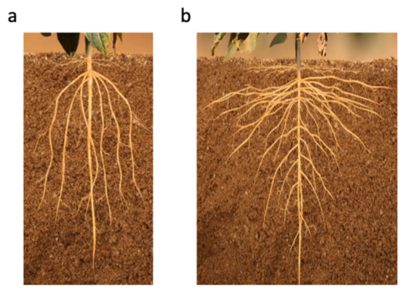Improvement of phosphorus acquisition by common beans in Mozambique
PDF
In these regions, one of the main constraints for bean cultivation is poor soil phosphorus content. Indeed, the traditional bean varieties that are widely used because they have desirable agronomic characteristics (color and seed size in particular) are not very efficient in taking up phosphorus from the soil. In addition, the use of fertilizers by farmers remains limited due to their high cost and supply constraints.
In Mozambique, breeders undertook the improvement of phosphorus acquisition and yields in common bean by improving the root traits of these varieties [2].To achieve this, a breeding strategy aimed at increasing root density in the shallow soil, where phosphorus is mainly available, was implemented (Figure 1).
Video: Improving phosphorus acquisition in beans in Mozambique:
A common bean variety identified as having a high number of shallow roots and a high density of long root hairs was identified. This variety was crossed with traditional varieties. After a first step of selection for agronomic traits of interest, the roots of progeny plants were characterized. Those with desirable root characteristics were selected and their agronomic performance was evaluated by breeders and farmers in different selection programs.
Finally, three new bean varieties named Kufuna, Tiyela and Matina with doubled yields in field conditions compared to traditional varieties were released in Mozambique. The seeds of these varieties are maintained at the Agricultural Research Institute of Mozambique, which works in collaboration with seed companies and farmers’ organizations for their multiplication and dissemination throughout Mozambique.
References
Cover image. From the video mentioned below, “Common bean varieties efficient in phosphorus absorption“, Roots Lab.
[1] Beebe S. 2012. Common bean breeding in the tropics. Plant Breeding Reviews 36
[2] Burridge JD, Findeis JL, Jochua CN, Miguel MA, Mubichi-Kut FM, Quinhentos ML, Xerinda SA, Lynch JP. 2019. A case study on the efficacy of root phenotypic selection for edaphic stress tolerance in low-input agriculture: common bean breeding in Mozambique. Field Crops Research 244, 107612




